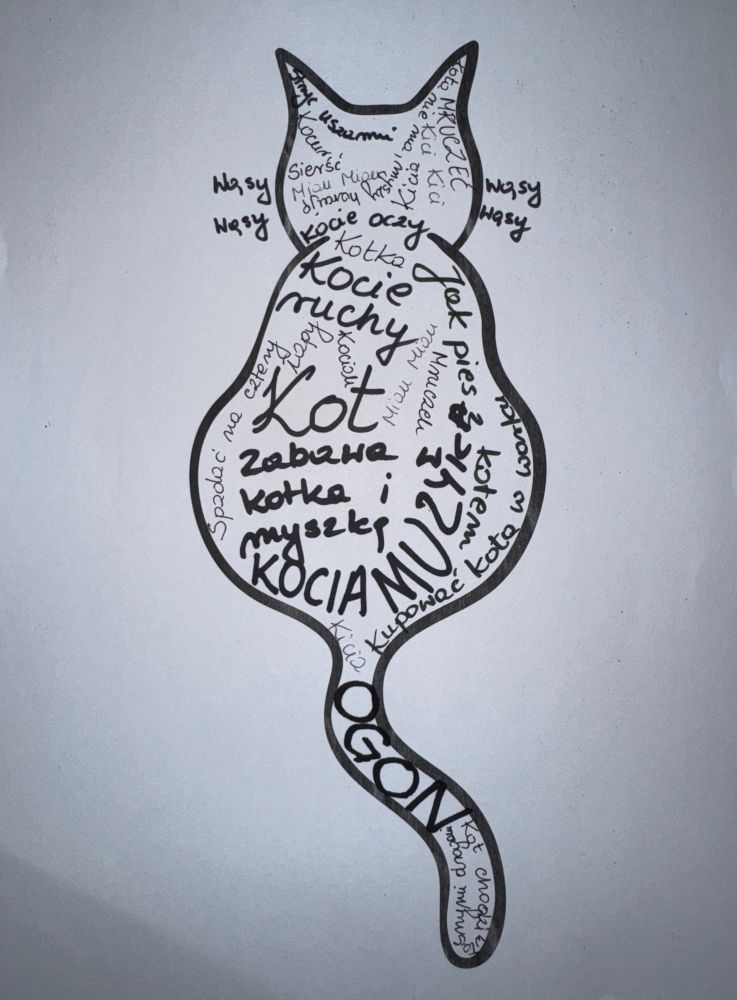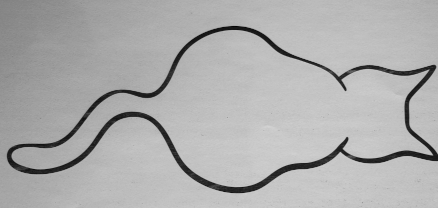Exploring Word Fields Through Calligrams
In this method, calligrams (or picture poems) serve as an inspiration for exploring word fields centred on common terms, such as the name of animals. Learners are asked to fill the silhouette of, say, a cat or dog with words and phrases related to the animal: its parts, synonyms, idioms, etc., thereby enriching their vocabulary in the heritage language.
Exploring Word Fields Through Calligrams
60 min
7 or above
Language Skills
A2 or above
up to 20 ppl
In this activity, participants use words to create pictures of animals, helping them practise their language and artistic skills at the same time. They learn new words, think about how languages are similar or different, and express their ideas in a creative way. By showing their work to others and talking about it, they also build confidence and learn to speak about their thoughts and choices in a group.
large sheet of paper (A3), pencil, eraser, writing utensils (e.g. felt pens of various strengths,coloured pencils); monolingual dictionary and graphical templates (optional).

Languages Available
1. Preparation:
Prepare handouts with examples of calligrams or set up the equipment for a screen projection.
2. Introduction to the activity:
Welcome everyone to the workshop and explain its nature and purpose. If the participants don’t know each other yet, you may want toorganise a short icebreaker during which they have an opportunity to present themselves and get to know each other. Use for example a Polish counting-out rhyme, where the designated persons presents himself or herself.
What are calligrams?
The term calligram designate a visual poem in which the text of a the poem forms at the same time an image related to. It was invented by theFrench poet Guillaume Apollinaire (1880–1918), whose portrait is shown on the left of the previous page. The poem reproduced to the rightof the previous page thus shows the images of a dove and of a water jet. By the way, the poet, although born in Rome, had Polish origins,since his mother was a member of the lesser Polish aristocracy of the Russian Empire and came from what is now Belarus. His full Polish namewas Wilhelm Albert Włodzimierz Aleksander Apolinary Kostrowicki, which he shortened for his pen name; the German Wilhelm became theFrench Guillaume.
However, it is not only poems that can be used to form images. Any kind of text, and even a single word, will do as long as they form a reccognisable shape that will enhance their meaning. Moreover, there are few constraints on the letters used, which can be slanted, stacked, curved or stretched to better fit the shape, just as in a puzzle. They can be of different sizes and in different styles, in the same colour or in a variety of colours. Words or letters can be handwritten or painted but it’s also possible to use ones that have been cut out from newspapers or magazines to create a collage.
3. Collecting words and phrases:
– Create widely popular calligrams of pets or domestic animals, such as of a cat, cow, dog or horse, because a rich vocabulary is attached to them and young heritage speakers are likely to be familiar with at least some of it.
– Create tandems or small teams of three to dress up vocabulary lists. For a cat calligram, for example, words might include those for different kinds of cats (kitten, tomcat, wild cats such as lynx or leopard, …) or races of cats (Siamese, Persian, Sphinx, …) , compound nouns (cat litter, cat ladder, …), a cat’s anatomical parts (paw, fur, whiskers, …) or its characteristics (independent, solitary, agile, …), verbs for the sounds cats produce (meow, purr, hiss, growl, …) or the way they behave (prowl, stalk, jump, crawl, stretch, doze, …), names of other animals, plants or objects that contain the word cat (cat shark, cat’s ear, cat’s cradle, cat stone, …), idioms (like herding cats, letting the cat out of the bag, fighting like cats and dogs, weak as a kitten, …) and sayings: ‘In the night all cats are grey.’ – ‘Curiosity killed the cat.’
– If participants are hesitant, provide some examples or hints in which direction to look for. Leave room for exchanges between all participants to promote peer learning.
4. Preparing the canvas and filling it with words:
– Ensure that all participants have a large sheet of paper, writing utensils (e.g. felt pens of different strengths, coloured pencils, water colours and a brush pen) and, if appropriate, a template with the shape of an animal in front of them.
– Ask them to lightly outline the shape of their chosen animal with a pencil; the line will be erased after the calligram will be completed.
A thick outline may also be a good choice if it fits the calligram better.
Black and white or colourful? It’s up to the artist.
You may want to make available a prepared canvas to younger children. Older participants are advised to reflect on the style in which they plan to execute the calligram: compact and detailed, bold and graffiti-like …, before starting to fill their calligram.
Excessive spacing and clutter should be avoided. The aim is to balance readability of the text and the artistic impact of the calligram.
The typographical choice should reflect theoverall mood of the image. For difficult parts, sketch the letters lightly with a pencil before creating a permanent version.
Don’t forget to indicate a time by which you expect the calligrams to be finished
5. Presenting and discussing the calligrams:
– Once the calligrams are finished, pin them to a wall or lay them out on a table and assemble the participants in front or around of them.
– Ask all or some of the participants to present their work. This includes explaining their aesthetic choice and the difficulties they have encountered, but also naming their favourite words and expressions.
– Ask participants to point out similarities and differences between the heritage language and the majority language – or, in a multilingual classroom, between the languages represented. Some expressions can be found across several language. ‘Curiosity killed the cat’, for example, has a Polish equivalent: ‘Ciekawość zabiła kota’, as has ‘In the night all cats are grey’ – ‘W nocy wszystkie koty są szare’. On the other hand, when animal sounds are imitated in human language, they often differ, at least in spelling: ‘meow, meow’ becomes ‘miau, miau’.

For Educators & Teachers
Preparation
-
Assemble a sample of calligrams from which participants can draw inspiration.
-
Prepare an animal-related vocabulary list to help participants with a lower level of proficiency.
-
Think of some guiding questions that help participants identify relevant vocabulary.
-
If appropriate, gather illustrations of animals or prepare templates of animal silhouettes.
-
Ensure that participants bring their own painting or writing materials or provide them.
Expected output
- Learners practise or discover new vocabulary related to common animals and potentially improve their spelling competence.
- New vocabulary is better memorised through the accompanying creative activity.
- Participants learn more about visual poetry and word art.
- Enhanced creativity, improved writing and soft skills such as team work, peer learning and communication skills.
Adaptation/Application of the method
a group with varied language proficiency
The workshop can be held in the heritage or the majority language with elements of the former, depending on proficiency levels. If these vary
considerably, consider letting participants work in tandems or small groups (incl. children and their parents). Consider using cut-out letters and
words from newspapers and magazines for participants with weak writing skills.
other languages
Calligrams of any kind can be produced in any language.
bilingual/Multilingual options
The activity can be adapted to bilingual or multilingual settings. In the latter case, emphasis should be put on comparing vocabulary across several
languages.
cultural context
Calligrams can be produced in all heritage languages with a writing system, although some languages, such as Arabic, may have a stronger tradition of calligraphy.
other age groups
The activity can be implemented for participants of all age groups, provided they have at least basic writing skills and knowledge of vocabulary inthe heritage language.
outdoor version
The activity can take place outdoors, at a table in a garden or park, under favourable weather conditions.
distance-learning option
– Online or blended settings are possible but will require adaptation and produce less interaction between participants.
– To avoid lengthy online sessions, activities should be split and some of the tasks be conceived as individual homework. Participants wouldonly meet online for presentations by the facilitator and to discuss individual results in a plenary session.
– Calligrams can also be created with image-processing software and a judicious use of a large variety of fonts.
challenges
– Participants with low proficiency levels in the heritage language may have to work with a much reduced vocabulary but can have recourse to adictionary to identify relevant words and phrases.
– To avoid difficulties less advanced learners in a group with different language proficiency levels, pair them with more proficient heritagespeakers and favour peer learning.
options for parents
– Parents who are native speakers of the heritage language can easily organise this activity for their child or children. – – The same is true for a parent with at least a basic knowledge of the heritage language (A2), who will at the same time have an opportunity toimprove his or her skills in this language.
Developed by / Origin / Original language
Katarzyna Włusek & Rupert Hasterok, Comparative Research Network e. V. – English, Polish
References, and Resources
Photos of the cat calligram (page 6), the silhouettes of a cat (pages 7 and 9) and of the writing utensils (page 9):
© Comparative Research Network e. V.
All other photographs and illustrations are from Wikimedia Commons and have been published under a Creative Commons Licence.
How to Write a Calligram Poem (With Examples): https://artsproutsart.com/calligram-poem-examples/
Calligrams examples: https://www.pinterest.com/barbaraeli/calligrams/
Similar Activities
Art and Fashion – The Wawel Heads
Museum visits are an excellent way to combine heritage language teaching and art. But what if no interesting museums are nearby? Here, virtual museums are a good alternative. In this workshop we aim to show how freely available online resources published by museums can be used for a wide variety of art-based learning activities.
Fold, Snip, Paste! – The Art of Polish Paper Cuts
Paper cuts are a long-standing tradition of Polish peasant culture. The best-known, from Kurpie and Łowicz, were cut with sheep shears. They range from simple to intricate designs, from single-colour cuts to collages and illustrated stories and have been used to decorate walls and windows. This makes them a perfect means to combine a creative activity with heritage language learning.
